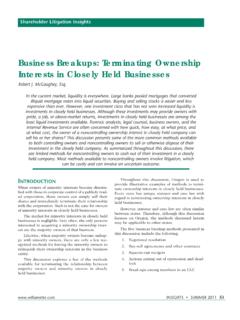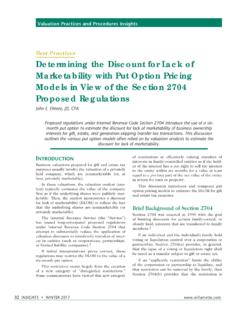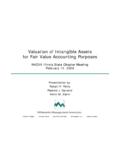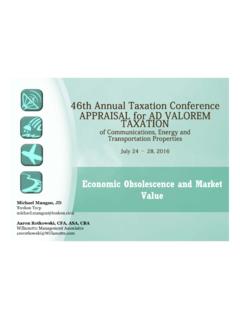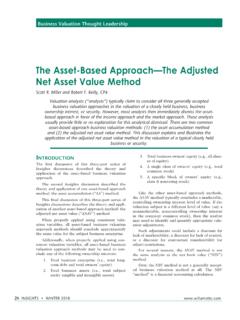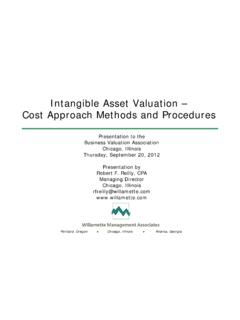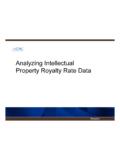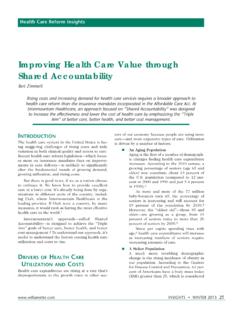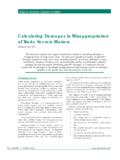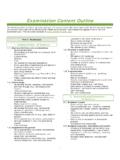Transcription of Practical Applications of Patent Valuation …
1 Practical Applications of Patent Valuation Approaches and Methods Speaker Biography For over 20 years, Robert Reilly has been a managing director of Willamette Management Associates. Willamette provides business Valuation , forensic analysis, and financial opinion services for transaction, financing, taxation, bankruptcy, litigation, and planning purposes. For over 30 years, Robert has focused on business and securities Valuation , intangible asset and intellectual property analyses, and on lost profits and economic damages analyses. Robert holds a BA in economics and an MBA in finance, both from Columbia University. He is a certified public accountant, accredited in business Valuation , and certified in financial forensics.
2 He is also a chartered financial analyst, certified management accountant, and certified business appraiser. Robert can be reached at (773) 399-4318 or at American Institute of CPAs 2. Discussion Outline Defining the Valuation analyst's assignment Data gathering and due diligence procedures Generally accepted Patent Valuation approaches, methods, and procedures Performing the Valuation synthesis and reaching the value conclusion Patent Valuation illustrative example Defending the Valuation analyst conclusion American Institute of CPAs 3. Defining the Valuation Analyst's Assignment Alternative intellectual property (IP) analysis purposes estimating a sale price between a willing buyer/willing seller estimating a royalty rate between a willing licensor/willing licensee estimating a value to the current owner/operator estimating a value to a specific buyer owner/operator estimating an intercompany transfer price (royalty rate)
3 Between related parties estimating economic damages related to an IP infringement or other damages event concluding the fairness of a sale price or a license royalty transaction concluding a mutual exchange ratio for two IP bundles estimating the IP collateral value for asset-based financing estimating the IP remaining useful life (RUL). American Institute of CPAs 4. Defining the Valuation Analyst's Assignment (cont.). Alternative IP analysis purposes intended objective: value (to an owner/operator), transaction price, third-party license royalty rate, lost profits/economic damages, fairness alternative standards of value (value to whom?). - fair value - fair market value - use value - user value - owner value - investment value - acquisition value - collateral value American Institute of CPAs 5.
4 Defining the Valuation Analyst's Assignment (cont.). Alternative IP analysis purposes (cont.). alternative premises of value (how the transaction occurs). - value in continued use - value in place (not in use). - value in exchange orderly disposition - value in exchange voluntary liquidation - value in exchange involuntary liquidation IP highest and best use (HABU) analysis - current owner/operator HABU. - new owner/operator HABU. - licensor/licensee HABU. American Institute of CPAs 6. Defining the Intellectual Property Develop a clear and complete definition of the Patent analysis subject intellectual property: patents, trademarks, copyrights, trade secrets other related intangible assets, such as: - trademarks advertising materials, trade dress - patents product/process drawings, proprietary technology - copyrights software, masks and masters - trade secrets customer lists, product formulae American Institute of CPAs 7.
5 Defining the Intellectual Property (cont.). Develop a clear and complete definition of the Patent analysis subject (cont.). types of patents - design Patent new, original or ornamental design for an article of manufacture; term is 14 years from date of grant - utility Patent covers the following inventions: a process, a machine, a manufacture, or a composition of matter; term is 20 years from date of filing - plant Patent for invention or discovery of a new and distinct variety of asexually reproduced plant; term is 20 years from date of filing - applied to and granted by the United States Patent and Trademark Office (USPTO). - protected by Patent Act, Title 35 United States Code - Patent requirements: useful, novel, nonobvious American Institute of CPAs 8.
6 Defining the Intellectual Property (cont.). Develop a clear and complete definition of the Patent analysis subject (cont.). subject bundle of Patent legal rights - fee simple - term/reversion interest - licensor/licensee interest - domestic/international interest - product line/industry interest American Institute of CPAs 9. Defining the Intellectual Property (cont.). Develop a clear and complete definition of the Patent analysis subject (cont.). Patent licensor/licensee responsibilities - legal protection - R&D expenditures - marketing expenditures - licenses, permits, regulatory approvals other Patent contract terms - minimum use, production, sales - minimum marketing, commercialization expense - R&D technology development, completion payments - obtain required approvals - milestone license payments American Institute of CPAs 10.
7 Valuation Analyst's Data Gathering and Due Diligence Procedures Patent analysis to the current owner/operator (use/user). historical and prospective financial statements historical and prospective development and maintenance costs current and expected resource/capacity constraints description and estimate of the Patent economic benefits - revenue (increase unit price/volume, market size/position). - expense (decrease product returns, COGS, SGA, R&D). - investment (inventory, capx). - risk (contracts, cost of capital). American Institute of CPAs 11. Valuation Analyst's Data Gathering and Due Diligence Procedures (cont.). Patent analysis to the alternative owner/operator (use/user). change in market definition or size change in alternative/competitive uses Patent creates inbound/outbound license opportunities owner operates and licenses Patent (in different products, territories, distribution channels).
8 American Institute of CPAs 12. Valuation Analyst's Data Gathering and Due Diligence Procedures (cont.). Analyze projections and Patent economic benefits against a benchmark comparison prior projections vs. prior actual results current projections vs. capacity constraints current projections vs. market size consider industry average comparable profit margins (CPM). consider guideline public company comparable profit margins consider quality and quantity of guideline Patent license data consider Patent RUL analysis, based on: - legal/statutory life - contract/license life - technology obsolescence life - economic obsolescence life - prior generations of the subject invention - position of the subject invention in its life cycle American Institute of CPAs 13.
9 Valuation Analyst's Data Gathering and Due Diligence Procedures (cont.). Analyze projections and Patent economic benefits against a benchmark comparison (cont.). data sources commonly used to identify industry average profit margins for Patent owner/operators - Financial Research Associates Financial Studies of the Small Business - The Risk Management Association Annual Statement Studies: Financial Ratio Benchmarks - BizMiner (The Brandow Company) Industry Financial Profiles - CCH, Inc. Almanac of Business and Industry Ratios - Fintel, LLC Fintel Industry Metrics Reports - MicroBilt Corporation (formerly IntegraInfo) Integra Financial Benchmarking Data - ValueSource IRS Corporate Ratios - Schonfeld & Associates, Inc.
10 IRS Corporate Financial Ratios American Institute of CPAs 14. Patent Valuation Approaches and Methods Income approach methods yield capitalization involves uneven income projections over a finite projection period direct capitalization involves an annual constant change rate income projection over either a finite period or a perpetuity period typical Patent income measures: - incremental/differential income (with vs. without the invention). - excess income/residual income (business enterprise income less capital charge on all contributory assets). - profit split (percentage of business enterprise income assigned to the subject Patent , based on a functional analysis ). - residual profit split (excess income split between two final intangible assets).
